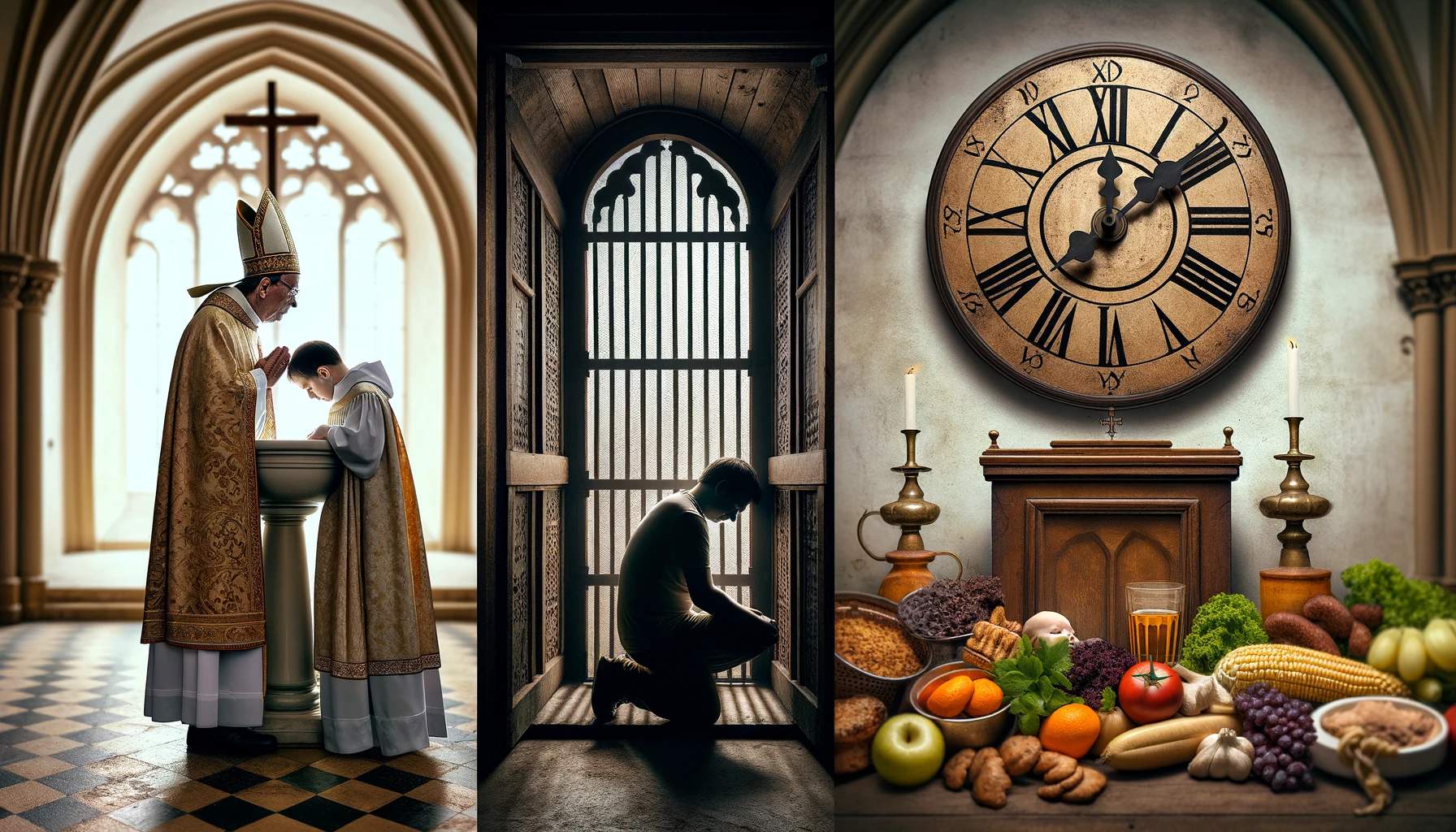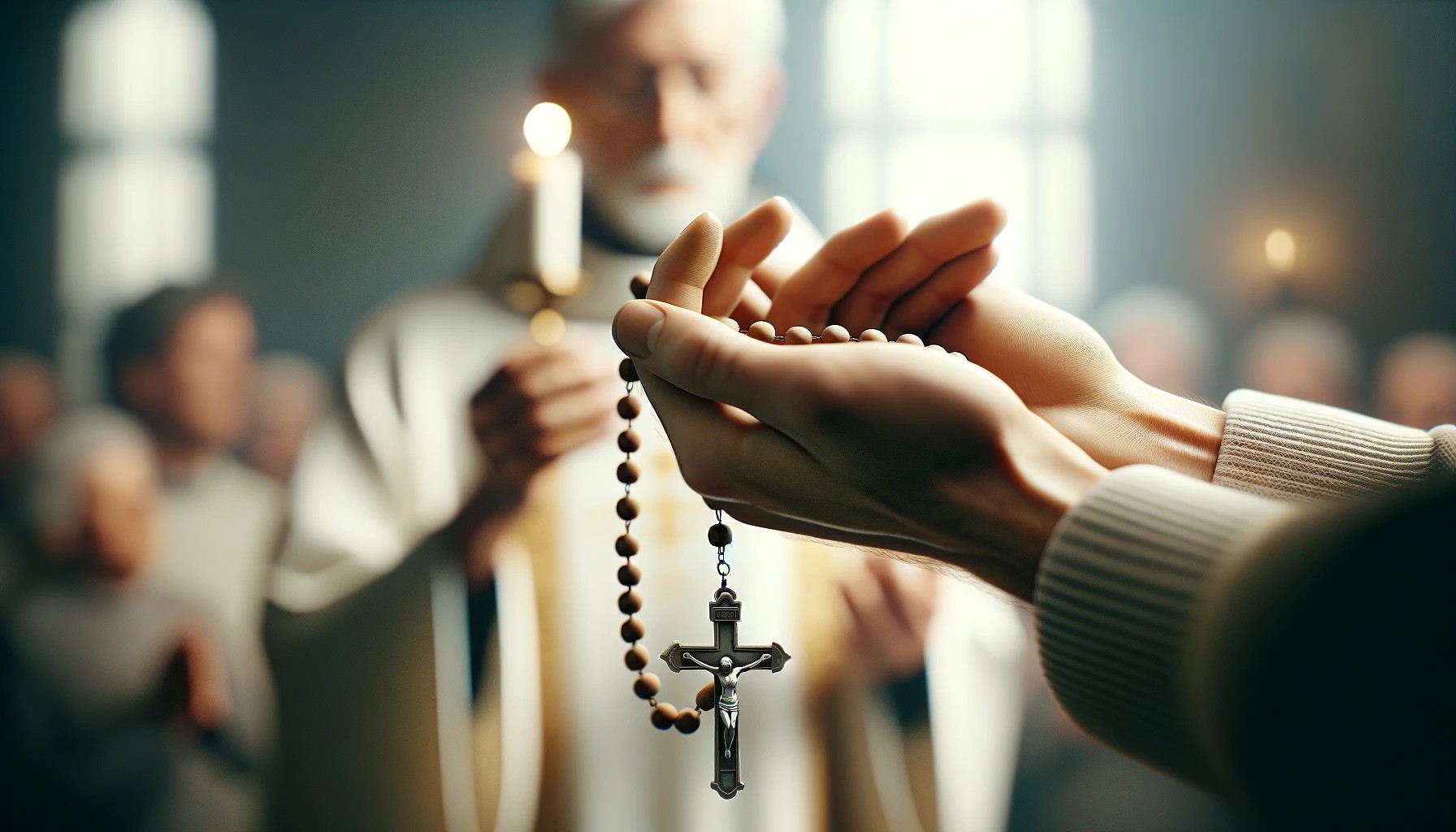Home>Theology and Spirituality>How Do You Receive Holy Communion


Theology and Spirituality
How Do You Receive Holy Communion
Published: February 24, 2024
Jason DeRose, Managing Editor at Christian.net, uses his expertise in religion and journalism to deepen understanding of faith's societal impacts. His editorial leadership, coupled with a strong academic background, enriches the platform’s diverse content, earning him recognition in both journalism and religious circles.
Learn about the theology and spirituality behind receiving Holy Communion and the significance of this sacred practice in the Christian faith. Gain a deeper understanding of the spiritual connection and reverence associated with the Eucharist.
(Many of the links in this article redirect to a specific reviewed product. Your purchase of these products through affiliate links helps to generate commission for Christian.net, at no extra cost. Learn more)
Table of Contents
Introduction
Holy Communion, also known as the Eucharist, is a sacred and central ritual in many Christian traditions. It is a profound and symbolic act that commemorates the Last Supper, where Jesus shared bread and wine with his disciples, instructing them to do the same in remembrance of him. This act of sharing in the body and blood of Christ holds deep spiritual significance for believers, representing the unity of the Church and the nourishment of the soul.
The ritual of Holy Communion is a tangible expression of faith, a moment of connection with the divine, and a communal experience that transcends time and space. It is a sacred encounter that invites participants to reflect on their relationship with God, their fellow believers, and the world around them. The act of receiving the consecrated bread and wine is a solemn and reverent practice that fosters a sense of spiritual intimacy and renewal.
As we delve into the intricacies of Holy Communion, we will explore its theological underpinnings, the preparation involved, the act of receiving the Eucharist, and the profound reflections that follow. This exploration will provide a deeper understanding of the spiritual significance of Holy Communion and its transformative impact on the lives of believers.
Read more: Why Do We Receive The Holy Communion
Understanding Holy Communion
Holy Communion, also referred to as the Eucharist, holds a central place in Christian worship and theology. At its core, Holy Communion is a sacrament that symbolizes the sacrificial death and resurrection of Jesus Christ. It is a sacred ritual that embodies the spiritual nourishment and unity of the Christian community.
The theological significance of Holy Communion is rooted in the events of the Last Supper, where Jesus shared bread and wine with his disciples, instructing them to partake in remembrance of him. This act established a profound connection between the physical elements of bread and wine and the spiritual presence of Christ. The bread represents the body of Christ, broken for the salvation of humanity, while the wine symbolizes the blood shed for the forgiveness of sins.
Central to the understanding of Holy Communion is the concept of transubstantiation or consubstantiation, which varies among Christian denominations. In Catholic and Orthodox traditions, transubstantiation is the belief that the bread and wine become the actual body and blood of Christ, while in some Protestant traditions, consubstantiation holds that Christ is present alongside the bread and wine in a spiritual sense.
Beyond its theological symbolism, Holy Communion serves as a unifying force within the Christian community. It fosters a sense of spiritual communion among believers, emphasizing their interconnectedness and shared faith. The act of partaking in the Eucharist signifies a collective remembrance of Christ's sacrifice and a reaffirmation of the bonds that unite believers as members of the body of Christ.
Furthermore, Holy Communion is a source of spiritual sustenance and renewal for the individual believer. It is a moment of intimate connection with the divine, where one receives the grace and blessings of Christ. Through the act of consuming the consecrated elements, believers seek spiritual nourishment, forgiveness, and a deepening of their relationship with God.
In essence, Holy Communion embodies the profound mystery of Christ's presence among his followers and the transformative power of his sacrifice. It is a sacred ritual that encapsulates the core tenets of Christian faith, emphasizing unity, remembrance, and spiritual nourishment. As we delve deeper into the significance of Holy Communion, we gain a richer understanding of its theological depth and its enduring impact on the spiritual lives of believers.
Preparation for Holy Communion
Preparation for Holy Communion is a vital aspect of the Eucharistic experience, encompassing both spiritual and practical elements. It involves a deliberate and mindful approach to readying oneself for the sacred act of receiving the body and blood of Christ. The preparation process serves to cultivate a reverent and receptive disposition, ensuring that participants approach the Eucharist with humility, introspection, and a sense of spiritual readiness.
Spiritual Preparation
Spiritual preparation for Holy Communion involves introspection, prayer, and repentance. It calls for a period of self-examination, where believers reflect on their thoughts, actions, and intentions, seeking reconciliation and spiritual cleansing. This introspective phase allows individuals to acknowledge their shortcomings, seek forgiveness for their transgressions, and realign their hearts and minds with the teachings of Christ. Through prayer and contemplation, participants prepare themselves to approach the Eucharist with a contrite spirit and a renewed commitment to living a life in accordance with the principles of love, compassion, and righteousness.
Sacramental Confession
In many Christian traditions, sacramental confession is an integral part of the preparation process for Holy Communion. This sacrament provides an opportunity for believers to confess their sins to a priest, receive absolution, and experience the restorative grace of God. By engaging in the sacrament of confession, individuals address any spiritual impediments and seek reconciliation with both God and the community of believers. This act of contrition and absolution contributes to the spiritual readiness required to partake in the Eucharist with a clear conscience and a purified heart.
Fasting and Abstinence
Fasting and abstinence are common practices associated with the preparation for Holy Communion. These disciplines vary among different Christian denominations but often involve refraining from food and drink for a specified period before receiving the Eucharist. The act of fasting serves as a physical and spiritual discipline, signifying a willingness to set aside worldly distractions and focus on the sacred nature of the Eucharistic encounter. It also underscores the symbolic significance of the bread and wine as the spiritual sustenance that nourishes the soul.
Reverent Attire and Demeanor
In addition to spiritual practices, the preparation for Holy Communion includes considerations of attire and demeanor. Participants are encouraged to dress modestly and respectfully, acknowledging the solemnity of the occasion. This outward expression of reverence reflects an inward disposition of humility and devotion, reinforcing the sacred nature of the Eucharistic encounter. Furthermore, approaching the altar with a demeanor of reverence and attentiveness fosters a sense of spiritual receptivity and openness to the transformative grace of the Eucharist.
In essence, the preparation for Holy Communion encompasses a holistic approach to readying oneself for the sacred encounter with the body and blood of Christ. It involves spiritual introspection, sacramental reconciliation, disciplined practices, and a reverent demeanor, all aimed at fostering a receptive and spiritually attuned state of being. By engaging in thorough preparation, participants honor the sanctity of the Eucharist and create a conducive environment for encountering the transformative presence of Christ in the sacrament.
Receiving Holy Communion
The act of receiving Holy Communion is a deeply reverent and transformative experience for believers. As participants approach the altar to receive the consecrated bread and wine, they engage in a sacred encounter with the body and blood of Christ, symbolizing a profound spiritual communion with the divine. The process of receiving Holy Communion involves a series of solemn and deliberate actions, each imbued with symbolic significance and spiritual depth.
As the moment of communion approaches, participants typically line up and approach the altar with a sense of anticipation and reverence. The act of queuing signifies a collective journey toward the spiritual nourishment and grace that the Eucharist represents. It fosters a sense of unity and shared purpose among the faithful, emphasizing the communal nature of the Eucharistic experience.
Upon reaching the altar, participants often make a gesture of reverence, such as a bow or genuflection, acknowledging the sacred presence of Christ in the consecrated elements. This act of reverence reflects a deep sense of humility and awe in the face of the divine mystery encapsulated in the Eucharist. It serves as a tangible expression of respect and devotion, underscoring the solemnity of the moment.
The reception of the consecrated bread and wine is a pivotal moment in the Eucharistic ritual. The priest or minister offers the consecrated host to each participant, uttering the words, "The body of Christ," to which the recipient responds, "Amen." This exchange encapsulates the essence of the Eucharistic encounter, signifying the offering and acceptance of Christ's sacrificial gift. The act of consuming the consecrated elements represents a profound spiritual communion with Christ, as believers partake in the body and blood of their Lord, receiving the grace and blessings that flow from this sacred union.
Following the reception of the Eucharist, participants often return to their seats in a spirit of contemplation and gratitude. This post-communion period allows for personal reflection and prayer, as individuals internalize the significance of the sacred encounter and the spiritual nourishment they have received. It is a time for silent communion with the divine, a moment of profound intimacy and connection with the transformative presence of Christ in the Eucharist.
In essence, the act of receiving Holy Communion is a sacred and transformative experience that encapsulates the core tenets of Christian faith. It embodies the spiritual communion with Christ, the unity of the Christian community, and the nourishment of the soul through the grace of the Eucharist. As believers partake in this sacred ritual, they are invited into a profound encounter with the divine, experiencing the transformative power of Christ's presence in the consecrated elements.
Post-Communion Reflections
After partaking in the sacred ritual of Holy Communion, participants often engage in a period of post-communion reflections, allowing for introspection and contemplation of the profound spiritual encounter they have experienced. This reflective phase serves as a pivotal moment for individuals to internalize the significance of the Eucharistic encounter and its transformative impact on their spiritual lives.
Post-communion reflections provide a space for believers to enter into a deeper communion with the divine, allowing the grace and blessings received through the Eucharist to permeate their hearts and minds. It is a time for silent contemplation, gratitude, and receptivity to the spiritual nourishment imparted through the body and blood of Christ. Participants are encouraged to embrace a spirit of openness and attentiveness, allowing the transformative presence of Christ to resonate within them.
During this reflective period, individuals often engage in personal prayer, expressing gratitude for the spiritual sustenance received and seeking continued guidance and strength in their faith journey. The post-communion prayers are characterized by a sense of intimacy and vulnerability, as believers offer their hearts and minds to the divine, seeking deeper communion and spiritual growth.
Moreover, post-communion reflections prompt individuals to consider the implications of their Eucharistic experience on their daily lives and interactions with others. The grace and unity symbolized in the act of Holy Communion inspire believers to embody the love and compassion of Christ in their relationships and endeavors. It serves as a catalyst for renewed commitment to living out the teachings of Christ, fostering a spirit of empathy, forgiveness, and service to others.
Additionally, the post-communion period offers a space for individuals to seek spiritual clarity and discernment, as they reflect on their personal journey of faith and the ways in which the Eucharistic encounter has deepened their connection with God and the Christian community. It is a time for self-examination and renewal, as participants strive to align their lives with the transformative grace they have received through the Eucharist.
In essence, post-communion reflections are a vital component of the Eucharistic experience, allowing believers to integrate the spiritual nourishment and grace received into their innermost being. It is a time for gratitude, introspection, and a renewed commitment to living out the profound implications of the Eucharistic encounter in their daily lives. Through post-communion reflections, participants continue to be transformed by the enduring presence of Christ in the sacrament of Holy Communion.
Conclusion
In conclusion, the ritual of Holy Communion stands as a profound and transformative sacrament within the Christian faith. Its theological depth, symbolic significance, and spiritual impact resonate deeply with believers across denominational boundaries. The act of partaking in the body and blood of Christ symbolizes a sacred communion with the divine, fostering unity within the Christian community and nourishing the souls of participants.
The understanding of Holy Communion as a representation of Christ's sacrificial death and resurrection underscores its central place in Christian worship and theology. The Last Supper, where Jesus shared bread and wine with his disciples, serves as the foundational event that imbues the Eucharist with profound spiritual meaning. Whether viewed through the lens of transubstantiation, consubstantiation, or as a symbolic memorial, Holy Communion remains a testament to the enduring presence of Christ among his followers.
The preparation for Holy Communion encompasses spiritual introspection, sacramental confession, fasting, and a reverent demeanor, all of which contribute to creating a receptive and spiritually attuned state of being. The act of receiving the consecrated elements at the altar represents a pivotal moment of communion with Christ, inviting believers into a transformative encounter with the divine. Post-communion reflections further deepen the impact of the Eucharistic experience, fostering gratitude, introspection, and a renewed commitment to living out the implications of the encounter in daily life.
Ultimately, Holy Communion serves as a tangible expression of faith, a moment of connection with the divine, and a communal experience that transcends time and space. It embodies the core tenets of Christian faith, emphasizing unity, remembrance, and spiritual nourishment. As believers partake in this sacred ritual, they are invited into a profound encounter with the transformative power of Christ's presence in the consecrated elements.
In essence, the ritual of Holy Communion encapsulates the enduring mystery and grace of Christ's presence among his followers, offering spiritual sustenance, unity, and a profound sense of communion with the divine. It stands as a testament to the transformative power of faith and the enduring presence of Christ in the lives of believers.













